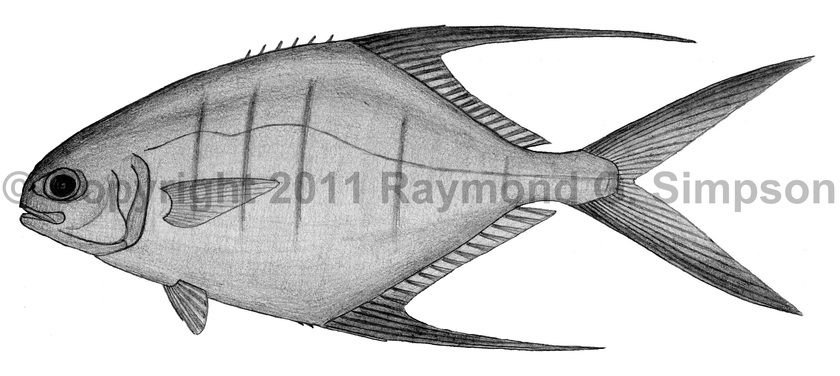
Common Name
Palometa
Year Described
Jordan & Evermann, 1896
Identification
Dorsal Fin: 6 very short spines, followed by I, 19-20
Anal Fin: 2 very short spines, followed by I, 16-18
Pelvic Fin: I, 5
Gill Rakers: 4-9 upper, 8-14 lower
Vertebrae: 10 precaudal, 14 caudal
Body diamond-shaped and deep, with deepest point at dorsal and anal fin base. Snout and head rounded, mouth subterminal. Small eye with jaw extending to mid-eye. Teeth small, present at all ages. Dorsal and anal fins (rayed portion) about equal in length, with greatly extended anterior lobes that extend well past caudal base when depressed. Tail large, deeply forked. Pelvic and pectoral fins small. Lateral line with small undulations, but straight at about origin of second dorsal fin, no scutes present on straight part. No caudal grooves or keels. Body smooth to touch with tiny cycloid scales, partially embedded in skin.
Color
Silvery, darkening slightly dorsally to gray or blue. 4 narrow black bars are present on the body, darkest near the lateral line. Often has additional spots along posterior lateral line. Lobes of dorsal, anal, and caudal fins dark and contrasting with body.
Size
Average size to 31cm. Maximum size to 51cm.
Habitat
Coastal waters near the bottom: sandy beaches, reefs, and rocky areas. Forms schools.
Range
Massachusetts to Argentina, including the Caribbean islands and Bermuda.
References
Smith-Vaniz, W.F. 2003. Carangidae (pp 1426-1468). In: Carpenter. 2003. The living marine resources of the Western Central Atlantic v. 3.